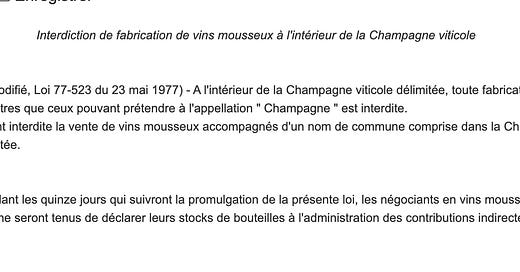In 2023 I wrote ‘The Structure of Champagne’ :
As Caroline Henry once pointed out to me, Champagne is the only appellation in the world you can’t leave. How come? Have a look at this regulation, contained in the production rules from the Champagne AOC:
Art. 1er, amended in 1977, states that it is illegal to produce any sparkling wines other than Champagne from within Champagne’s designated production zone.
Ever wondered why there aren’t any rebels in Champagne? Why, as they have in almost every other major European wine appellation, a few bold souls haven't left? Why there aren’t any cheeky Meunier Pet Nats from guys in baseball caps down the end of the Marne Valley?
Well, know you know. Rebellion is, well, outlawed.
Let that sink in for a minute. Imagine you’re in Tuscany, and you’ve planted Malbec. OK, you might not be able to call it Chianti….but you can call it something. You can sell it. If you don’t want the appellation - Rioja, Bourgogne, Monferrato, whatever - you can still make wine. There’s nowhere else in the world (at least that I know) where it’s the Appellation way or the highway, though.
Although Champagne’s increased focus on single terroirs is undoubtedly rather Burgundy-like, the overwhelming reality is that the broad appellation is the boss. What would Champagne be like, though, if it contained smaller appellations? If some of the so-called ‘Grand Cru’ and ‘Premier Cru’ villages really were organised like Burgundy?
‘Volnay’, for example, is not just a nice name on a label of red burgundy. It’s an appellation in its own right. In fact, there are 84 appellations within burgundy, ranging from ‘village’ level wines to Grand Cru vineyards, each with its own production rules. Volnay, then, was able to ban herbicides in 2023 in its own appellation for Premier Cru wines, even if other ‘Premier Cru’ Burgundy wines have not.
Let’s forget, for a moment, practical and commercial realities of today, and get into thought-experiment mode. To be clear, this isn’t a thought experiment I’d advocate for (let alone one that I ever think would come to pass). It does, however, shed some light on some of Champagne’s more insoluble issues.
The village of Avize, in the Côte des Blancs, is currently able to call itself ‘Grand Cru’ on a label, no matter where the grapes come from in the village (whereas in Burgundy specific parts of each village are designated Grand and Premier Cru). This allows a village co-operative in Champagne to turn out perfectly decent wines and call them ‘Grand Cru’, making Champagnes the cheapest of France’s ‘Grand Cru’ labels.
A theoretical breakaway (or sub-) appellation for say ‘Avize Grand Cru’, or ‘Côte des Blancs Grand Cru’, could specify yield and viticultural restrictions (for example, 12,000 kg per hectare agronomic yield, no herbicides and a minimum of three years on lees). It could even choose to exclude certain vineyard zones.*
It could specify, as it does in Corpinnat, a certain percentage of bought-in grapes. Or a limit on wines that can be bought (large quantities of Chardonnay in the Côte des Blancs are vinified in co-ops and sold on as base wine to houses).
Who might use it? At present, probably nobody (unless the word Champagne could still be on the label). Would the wines made under these conditions necessarily be better? They would argue so, but the reality would be messier. They would, at least, be escape the grip of the over-arching political pressures of the appellation, which is bound to satisfy the dentists selling their family plots by the kilo as much as it is the top-quality producers putting their own names on the label. A producer leaving Champagne would arguably be the biggest earthquake in a hundred years.
Such a situation would only come about, as it did for the Corpinnat producers in Catalunya, if the Champagne name becomes more of a hinderance to their personal reputation than a bonus. Is that even close?
It seems unlikely. But not inconceivable. Wine is finally waking up to a future where casual drinking is not a safe chunk of the bottom line. Where cases of budget champagne don't just sell themselves on the C-word alone. Where big brand drinks are the things your parents drank.
Champagne can never be even remotely like Burgundy, with its pixelated, complex sense of locality. But whether large, protective appellations, designed in part to assure the viability of their volume production as well as their quality, are set up to thrive in the coming decades seems to be open for debate.
*Champagne could, theoretically, do this right now for the terms ‘Grand Cru’ and ‘Premier Cru’; however the ability to tag on these terms for any wines made in the correct villages comes with no additional requirements over general Champagne AOC production, and there's little appetite to rock the boat with something so controversial…






